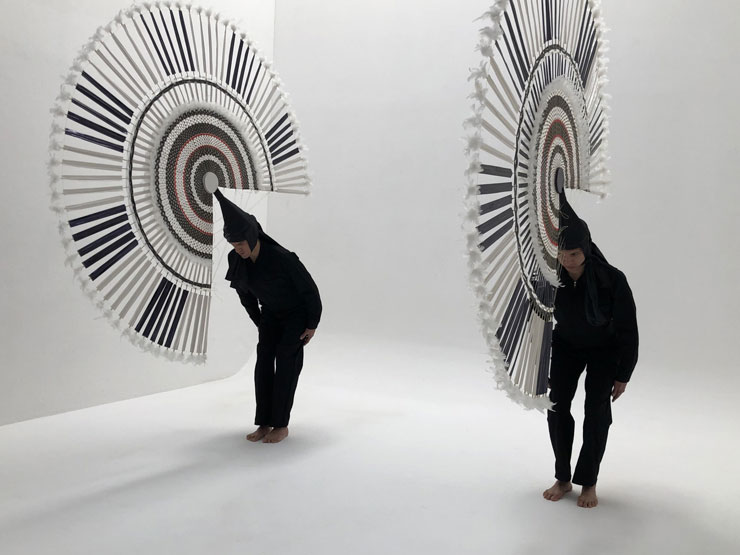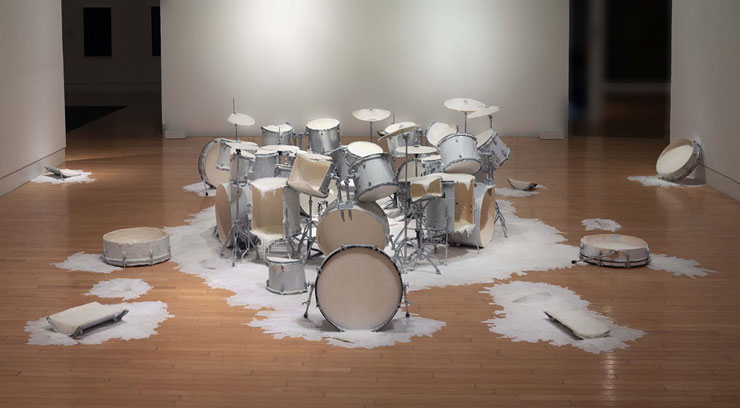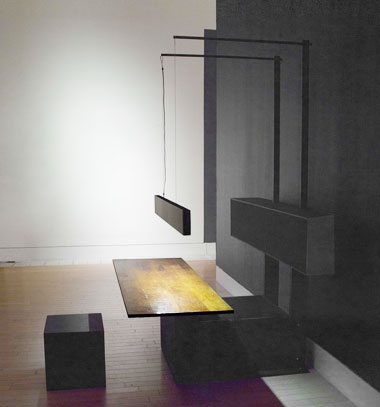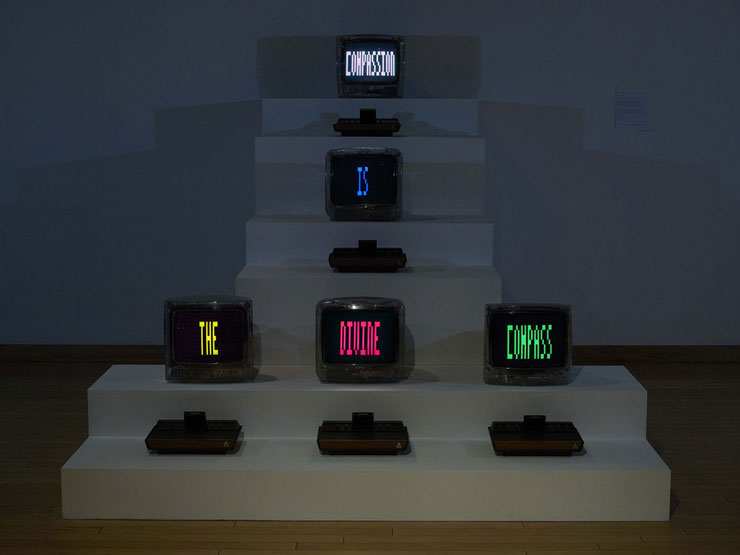
Tania Candiani (b. Mexico) "Reverence" (Photo: Lowe Art Museum)
"Beyond the Sounds of Silence: Latin American Artists Connecting Sound, Art, and Society" at Lowe Art Museum, U of M campus.
"Beyond the Sounds of Silence: Latin American Artists Connecting Art, Sound, and Society," on view at the Lowe, is only running through Oct. 2, so you better get on it.
The long title suggests the general overview, but it gets more complicated than that. I had to spend time in the galleries to unravel each artists' specific societal interpretation. It was more vast a subject than I had anticipated at first blush. Some exhibitions disappear from mind soon after you leave the premises. Not this one. I found the concepts remained long after.
Incorporating sound with visual art adds a second sense to parse thorny universal dilemmas. "Polyphony" is a word that applies here, according to the curatorial statement. A conceit developed and coined by Russian philosopher Mikhail Bakhtin (1895-1975), and refers to "a philosophy of language and a social theory that Life is dialogic and a shared event."
Facing mind-crushing problems, we stumble over each other in an attempt to find mutual respect and solutions…a puzzle that seems to acquire more mismatched pieces every year. This exhibition attempts to discuss many on a personal level with the dual tools of art and sound. The "music of reality" comes alive in the thoughtful reverie of these multi-dimensional artists.

Tatiana Blass (b. Brazil) "Half of the Speech on the Ground." (Photo: Lowe Art Museum)
Nineteen artists, born between 1943 and 1986, from ten Latin American countries, participated. Tatiana Blass (Brazil) has us watch video performances titled "Half of the Speech on the Ground." One selection shows hot wax and Vaseline poured over and into a beautiful grand piano, played until it no longer can produce sound. It’s a distressing visual (to me) of muting beautiful works of Chopin, ultimately coming to strangulation and silence.
Tania Candiani (Mexico) also expresses through video with "Language as a Sound." It’s based on the musicality and rhythm of the Polish language. Listening to words I do not understand opened a moment to fully appreciate the ebb and flow of verbal resonance… absorbing the pure cadence of language in the 6 distinct notes of the multi-channeled piece. A small choir had been recorded at the Royal Gun factory in Gdansk, the cavernous empty old walls and doorways creating an eerie reverberation and depth of emotion.

Gustavo Matamoros (b. Venezuela) "Small Sounds on a Table." (Photo: Lowe Art Museum)
The day I visited was one of Miami’s boiling hot August days, a short stroll over the U of M campus sucking the life out me. Entering the cool dark exhibit in the Lowe Museum was a perfect setup to slow down, take time to remove myself from the afternoon’s onslaught, and see a bigger story presented by artists of varied cultures. I happily meandered from one concept to another, figuring out how and why each piece was conceived.
I sat down at artist Gustavo Matamoros's (Venezuela) “Small Sounds on a TableTop.” A rectangular tabletop was made of smooth glossy wood, a black box hood hovering overhead. I was directed to lean in but not touch the tabletop. I hoped I wouldn’t lean in too far under the low hood and fall onto the table. Sounds seemed to envelop me from somewhere inside myself. Matamoros clarified that the noises were made through the manipulation of thin wires, a cat’s whisker, beach sand, rubber bands, etc, emulating natural sounds. Curatorial notations aided to unwrap surprises held in each piece.
A fairly large exhibition, the concept is from the minds of the Aluna Curatorial Collective.
I had a few questions for Adriana Hererra, Co-Founder with Guillermo (Willy) Castellanos, of Aluna Art Foundation.
Irene Sperber: What aspect of the exhibit is the most eloquent in communicating what Aluna brings to the community?
Adriana Herrera: "The space of intersection between the works, arising from a legacy that, on one hand, connects to figures such as John Cage and his piece 4' 33", but on the other, recovers the frictions of a historical past, demonstrating the creative persistence of Afro-Brazilian and indigenous heritage. Numerous works sink their process in the roots of ancestral cultures, drink from the modernism of the global North; and are built with their own mode of universal identity arising from the particular condition of our hybrid cultures. The multi-temporality and multiculturalism of works by Latin American-born artists is powerful and somehow subverts the direction of colonialism. Aluna Curatorial Collective seeks to broaden the dialogues and demonstrate how cultural appropriations from the South to the North help rewrite art history."
"There is a room where Magdalena Fernandez's videos allude to modernist abstraction references but "contaminate" them with the sound of kisses or frogs. That "concert" merges with Polish syllables from a piece by Tania Candiani and the Aymara voices of a hologram by Sonia Falcone. Then there are the silent scores of Manuel Rocha Iturbide, which quote previous probes by authors such as Anthony Braxton, but create a unique iconographic score. At the same time, numerous sound instruments use silence to give voice to what is inaudible to us: the voices of trees enclosed in the skin of their bark (María Elena Gonzalez), the cry of miscommunication (Tatiana Blass), or the sound of a dead piano that a composer (Manuel Rocha Iturbide) would like to revive in the form of a fragile sculpture. The dialogue between the artworks makes each piece more powerful.

Yucef Merhi (b. Venezuela) "Compassion." (Photo: Lowe Art Museum)
IS: Was there anything new that opened up that you hadn't anticipated once the exhibit was installed?
AH: "The multiple concerts created in the two galleries by the fusion of sounds and visions. In the section dedicated to the pre-Columbian legacy, the rainsticks of the piece Ucayali (as the name of a river) by Cecilia Paredes communicate with the sound of the whistling bottle built by Enrique Ramirez. Both pieces are related to a call for taking care of our planet's water. The sounds of the room dedicated to sound art with pieces by Richard Garet, Gustavo Matamoros, and Rolando Peña demand very particular attention to be heard and/or seen. This is an invitation to another way of being in the world."
"In the Beaux Gallery, we gathered five works representative of the conceptual zones of the exhibition (sound art investigations: Alba Triana, soundscape: Muu Blanco, works that connect art-sound and society: Yucef Merhi and Antonio Vega Macotela, and that recover the ancestral legacy: Tania Candiani). We were surprised by the unplanned encounter between sacred sounds of the Aztec tradition; Buddhist and Christian bells, built with different pieces; and the sound extracted from the shape of a cymbal that reminds us that everything vibrates and has a sound in the universe. We created, without initially thinking about it, a meditative space in an atmosphere of low light that requires us to pause and listen.”
Also connecting with Jill Deupi, Director and Chief Curator of the Lowe Museum, I had to ask how this show speaks to the central concerns that the Lowe museum wants to bring forward in the public forum?
"The Lowe is dedicated to exploring contemporary culture through 5,000 years of human creativity," says Deupi. " 'Beyond the Sounds of Silence' beautifully advances this commitment by highlighting some of today's most talented artists, many of whose practices are inspired and informed by art's many histories, across time and around the globe. This exhibition also squares perfectly with the University of Miami's commitment — which we also fully embrace — to serving as a leader in our hemisphere; a commitment that includes elevating and amplifying the voices of artists from across Latin America and the Caribbean. Similarly, BTSOS speaks to our shared commitment to exemplarity in the realms of interdisciplinary inquiry and cross-curricular collaboration.”
Participating artists include: Tatiana Blass, María Elena González, Magdalena Fernández, Glenda León, Manuel Rocha Iturbide, Tania Candiani, Sonia Falcone, Cecilia Paredes, Nicolás Varchausky, Enrique Ramírez, Vivian Caccuri, Iván Grillo, Alba Triana, Richard Garet, Gustavo Matamoros, Rolando Peña, Antonio Vega Macotela, Muu Blanco, Yucef Merhi
Lowe Art Museum at the University of Miami in Coral Gables can easily be overlooked. Limited hours and tucked into the interior of the U of M campus combine to make a drop-in more complicated. However, the effort is worth it for the content Lowe offers on a regular basis in myriad galleries.
Lowe Art Museum
1301 Stanford Dr
Miami 33146
www.lowe.miami.eduHours
Open Thursday, Friday, Saturday only: 10 a.m. - 4 p.m.
They have regular on line and on site events. Tune into their calendar so you don’t miss anything.
www.lowe.miami.edu/calendar/index.html




